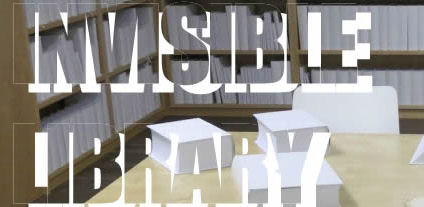Inspiring Older Readers
 posted on 02 Aug 2017
posted on 02 Aug 2017
Taking a trip to the Invisible Library
The other day when I had way too much time on my hands I was grazing on some book-related websites and came across a mention of the notion of an ‘Invisible Library’. Reading on a little way it became clear that this seeming oxymoron was a term applied to fictitious books that appear within works of fiction – if you see what I mean. Maybe the blog site set up to create a list of these fictional works of fiction puts it better:
( The Fictional Library is) a regularly updated catalog of books that exist only within other books – a Borgesian invisible library.
Although the blogsite is still accessible on line it seems that the last entry was in fact made back in 2008 – although a pretty substantial list of ‘invisible books’ had been recorded by that time.
Of course there’s nothing particularly new about the creation of a fiction within a fiction – Shakespeare’s Hamlet famously has The Murder of Gonzago as a play within a play. This device can be traced back even further to Thomas Kydd’s Spanish Tragedy of 1589 – well before the novel as a form was even thought about.
The ruse of creating a whole extra layer of fiction within an existing fiction must be to draw us deeper into the world of the book we’re reading, giving the plot a spurious validity or sense of authenticity.
The existence of this catalogue for an invisible library did, however, make me think about how this related to other similar literary ‘tricks’ that writers have used to take us further down the rabbit hole. One such stylistic affection that became popular in the second half of the 20th century was what has become known as ‘metafiction’ – where amongst other things the author self-references the authorial process ( think Italo Corvino, John Barth, Kurt Vonnegut etc.). This leads to deliberate confusion between reality and fiction; it questions the role of creation by the writer and the reader’s co-construction of events. It’s like reading in a hall of mirrors.
Then there’s the story within a story or the creation of simultaneously running stories where neither is clearly defined as the ‘real’ narrative – the Thousand and One Nights might be a quite simple example of this but much more recent novelists like Thomas Pynchon, Margaret Atwood for example have complicated this process considerably.
Slightly tangentially, one of my personal favourites when it comes to books within books is the creation of fictional bookshops and book dealers. This gives the author a chance to conjure-up not just non-existent tomes but whole idealised environments – bookshops in particular help create potent atmosphere. Particularly good examples of this can be found in Zafon’s Shadow of the Wind or Perez-Reverte’s The Dumas Club but there are very many others.
All very interesting if a bit nerdy.
I don’t think I’ve ever found myself wishing I could actually read one of these mythological books but others clearly have. Writing for the Book Riot website, Annika Barranti Klein (http://bookriot.com/2017/07/26/6-books-from-the-invisible-library-i-wish-were-real/) offers up the half a dozen books she wishes were real.
If you want to explore the list and ponder what these unwritten books might find their way onto your shelves if only someone would write them, click on this link and start dreaming.
http://invislib.blogspot.co.uk/
Terry Potter
August 2017